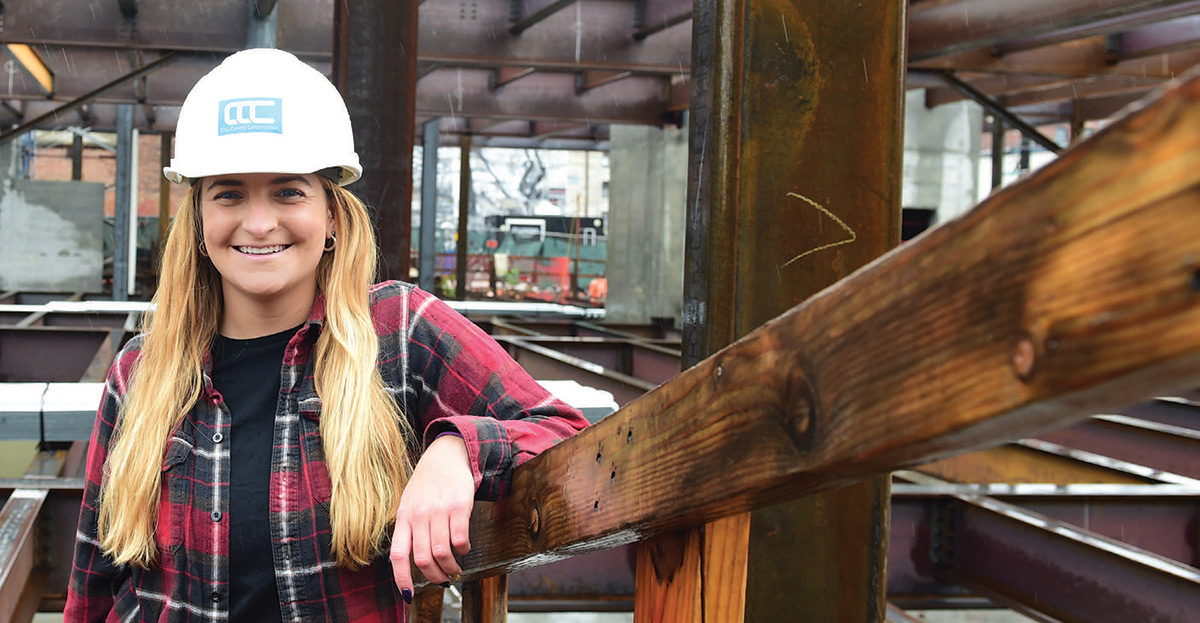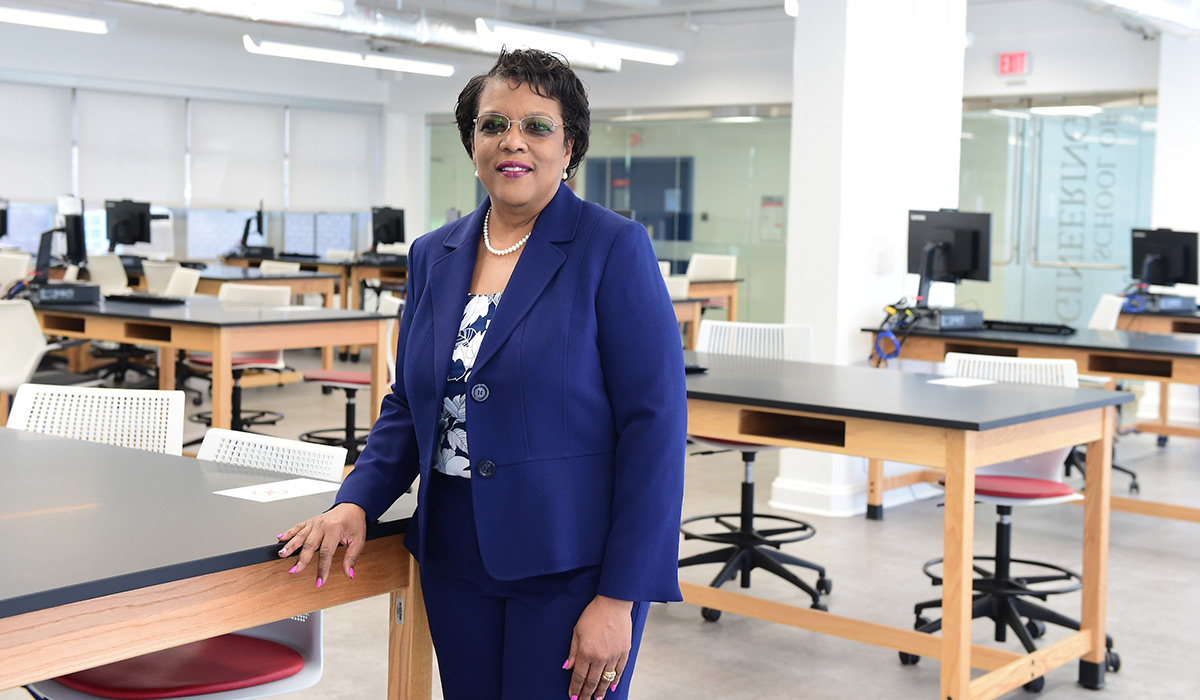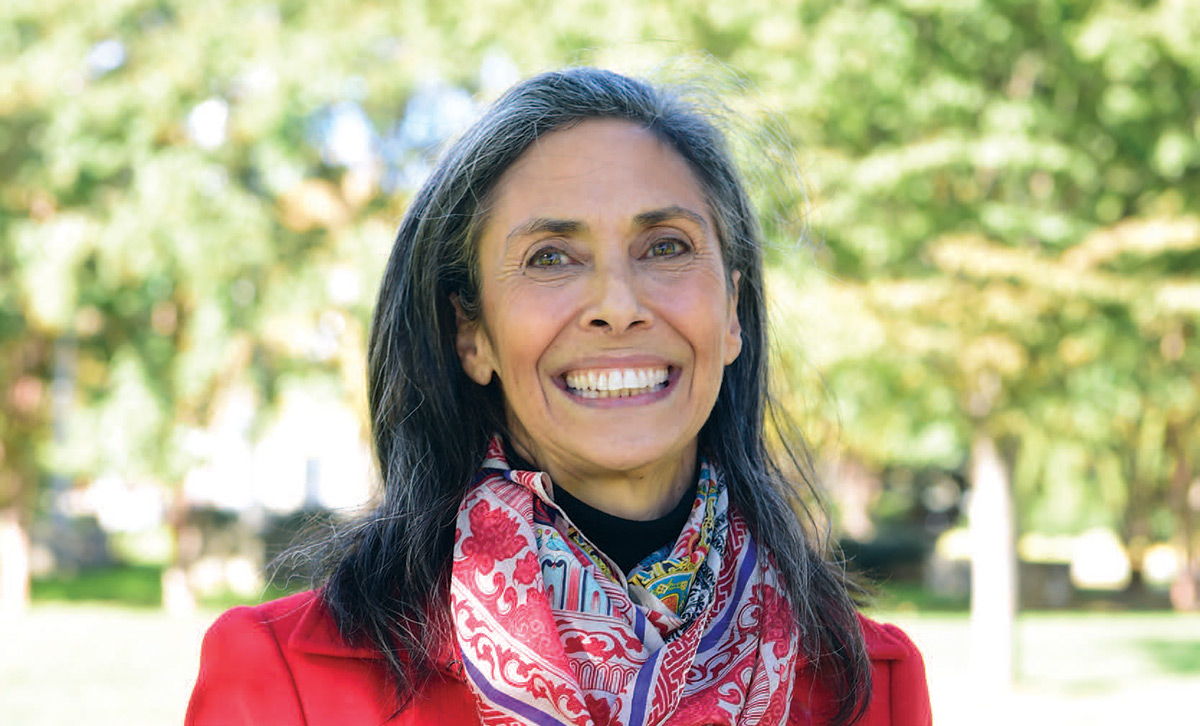

By Gabrielle Obusek
CatholicU, Winter 2021
The School of Engineering’s student body features strong representation from women — at rates twice the national average.
 If bedtime stories are the stuff that dreams are made of, then thousands of little girls fall asleep at night with dreams of becoming an engineer. The beloved children’s book Rosie Revere, Engineer lets them know they can be creative problem solvers. Parents no doubt read the book, and others like it, to their daughters with hopes of sending the message that there are no limits to what girls can do when they grow up — and that includes pursuing careers in traditionally male-dominated fields in science, technology, engineering, and mathematics (STEM).
If bedtime stories are the stuff that dreams are made of, then thousands of little girls fall asleep at night with dreams of becoming an engineer. The beloved children’s book Rosie Revere, Engineer lets them know they can be creative problem solvers. Parents no doubt read the book, and others like it, to their daughters with hopes of sending the message that there are no limits to what girls can do when they grow up — and that includes pursuing careers in traditionally male-dominated fields in science, technology, engineering, and mathematics (STEM).
Those dreams become reality in college programs that encourage bright young women to fill the seats in their classrooms and research labs.
“The Catholic University School of Engineering has created an environment where female students can contribute their problem-solving abilities not only in class, but also in research,” says Hieu Bui, assistant professor of electrical engineering and computer science. “Faculty in the school believe in their capabilities, talents, and skills.”
That confidence in women is paying off. A recent report from the American Society for Engineering Education (ASEE) showed the school’s percentage of master’s degrees awarded to women in 2018 was second highest in the nation. The school’s graduate programs host, on average, 36% women students. Last semester, 35% of undergraduate computer science students were female, nearly twice the national average (18%). The computer science and biomedical engineering programs draw the highest number of female students.
Although computer, mathematical, and technology occupations are projected to be among the most rapidly growing professional fields in the next decade, women currently make up just 24% of the STEM workforce, according to the U.S. Bureau of Labor Statistics. There is clearly still work to be done.
In a recent article published by Catalyst, an organization that works with companies to create welcoming workspaces, it was explained that women in STEM face discrimination and isolation due to the relative lack of peers, role models, and mentors — and they are paid less than their male colleagues. It has also been found that women leave STEM careers at higher rates than men.
Lin-Ching Chang, associate professor in electrical engineering and computer science, remembers her first job after graduate school was as a software engineer — the first woman her company ever hired for such a position.
“The chief engineer officer, who is also the founder of the company, told me that he used to think, ‘Women cannot code,’” Chang says with a smile before adding, “Our world as a whole is in need of more scientists and engineers. We need to find ways to encourage girls and young women to major in STEM.”
“We need the most talented and capable people,” agrees Peter Lum, chair and professor of biomedical engineering. “When I see the low numbers of women in STEM, I think of untapped potential.”
Having clubs and networks for women and providing funding and research opportunities, in Chang’s and Lum’s view, are ways to lessen these disparities. Studies have shown that girls who participate in STEM clubs and activities are more likely to pursue these subjects in their education, which is why the School of Engineering organizes summer camps and competitions to expose high school students to the field. CatholicU students also have created a number of networking organizations to help each other in their programs, including the Society of Women Engineers.
Mina Larraquel, B.S. 2020, founded Upsilon Pi Epsilon, the University’s first computer science honor society, in 2019. “My definition of an honor society is that it recognizes individuals for excellence in their academic and professional achievements,” says Larraquel. “I wanted to establish an honor society that celebrated students not only academically, but professionally too.”
In 2017, she helped to revive the University chapter of the Association of Computing Machinery (ACM), an international society for computing. “This is an organization where everyone can interact with different grades, share experiences, and form life-lasting bonds that can help support us through this major,” says Larraquel. “Our entire executive board of ACM is female, which really shines a light on how the major is becoming more diverse.”
Larraquel says it is also important to increase the visibility of women (both students and faculty) as role models.
“I went to Cardinal Preview Day as a high school student and saw a female student in computer science. It just clicked that I wanted to be just like her when she talked about her Research Day projects and microprocessing classes,” she says.
“I believe the most efficient way to encourage and motivate young women in STEM is to give them more role models,” says Minhee Jun, assistant professor of electrical engineering and computer science. “We need to see to it that not only is it possible for women to achieve a career, but also that it becomes the norm.”
Melissa Sandison, doctoral candidate in biomedical engineering, has a similar idea, stated a little differently. “I don’t think of myself as a woman engineer; I think of myself as an engineer.”
Sandison is conducting her research at MedStar National Rehabilitation Hospital. “CatholicU has good connections in the field, which means I get to interact with lots of doctors, engineers, and patients. I didn’t see these types of partnerships with other schools I considered applying to,” she says.
“As STEM moves toward the future, the field requires a diverse set of skills, and women like our students are paving the way,” says Laura Micheli, assistant professor of civil engineering. “We need more women in STEM, not only for a future that benefits women equally as men, but to find better solutions to global challenges.”
Making the world a better place — that’s a dream worth realizing.
More to Come: Future issues of CatholicU will feature more women in science — in fields such as physics, chemistry, and biology. Stay tuned!

She loves the sights and sounds of a construction site.
While exploring her college options, MaryKate Selgrath, B.C.E./B.Arch. 2019, had a checklist of factors that were important to her. She wanted a strong civil engineering program. She wanted to be in a major city. And she wanted to see female students in the engineering classroom. She visited Catholic University. Check. Check. Check.
“Location was huge for me,” says Selgrath. “For a student who is interested in building and architecture, being in D.C. is pretty incredible. The buildings represent every style imaginable and the way the city is laid out is also spectacular. The great history, along with all the new projects — it’s different than any other city.”
Selgrath always enjoyed math as a young student. While in high school, a teacher recommended engineering as a field that might interest her, so she took an introductory course. “I found civil engineering so interesting. I loved the idea of seeing my drawings come to life, looking out the window and seeing buildings I helped design. I like tangible results.”
When she began to share her career plans, she heard reactions that surprised her. “People would say things like, ‘You’ll have to be tough to be with all those boys.’ It was kind of disheartening. That’s why I wanted to know the number of women in the program when I considered Catholic, and it was a good percentage. I was never the only girl in the classroom. I wish I had more female professors, however, and I think that’s an area where the University can improve.”
As a student in the five-year dual degree program in civil engineering and architecture, Selgrath served as the president of the University’s student chapter of the American Society of Civil Engineers (ASCE). She helped plan the ASCE conference on campus, which involved raising $56,000 and hosting 350 students from 14 universities.
“While organizing the conference with the other schools, I was working with mostly men,” recalls Selgrath. “I’ve made a lot of male friends in this field, and they’ve been nothing but supportive and collegial.”
Still, she wants to see not just more women in the field, but more girls simply made aware that engineering, in general, and civil engineering, in particular, can be options. Now working as an assistant project manager with Philadelphia’s City Center Construction, Selgrath helps mentor high school students through an initiative called Student Global Ambassadors Program, founded by CatholicU biology alumna Michele Joseph (for more on this program, see page 45).
It is a logical extension of Selgrath’s time as a student, when between classes and two internships at Davis Construction she helped institute a new mentoring board in the civil engineering department, and served as a Cardinal Ambassador. She was honored for her academics and student involvement when she received the first Dean Charles Cuong Nguyen Leadership Award.
“The schools of engineering and architecture are close-knit communities. The professors know you and they are happy to help you get your foot in the door,” says Selgrath, who is currently working on two residential projects in Philly’s Northern Liberties neighborhood. One is a ground-up construction project. The other is a renovation of the historic Harbison Dairy building. The local landmark features a giant milk bottle atop the building, which once functioned as part of a water supply system. The iconic bottle will be preserved in the renovation.
Happy in a job that involves a myriad of skills including scheduling, budgeting, site supervision, and reviewing building plans and permits, Selgrath says, “I love construction. It’s very people-centered. It takes a lot of coordination, teamwork, and problem solving. There’s something different every day. I love the sights and sounds of a construction site, and I’ve never minded a hard hat.” — E.N.W.

During 30 years at NASA, she’s seen a change in the number of women in the field.
“I want to be known as an engineer,” says Wanda Peters, B.S.E. 1989. “I think like an engineer, not like a woman engineer.”
After 30 years at NASA, first as a contractor and then in a series of positions of increasing responsibility, Peters recently became the deputy associate administrator for programs in the space agency’s Science Mission Directorate. She has seen a change in the number of women in the field.
“When I first started at NASA, as a support contractor, I would be the only woman, or one of the few women, in meetings,” Peters says. “Now you see a lot of women with a seat at the table — women who are technical experts, who are the heads of technical organizations and the leads for programs and projects.”
A “daddy’s girl” in her own description, Peters was interested in science and engineering from childhood. Her father, a former U.S. Air Force mechanic, made sure she and her two brothers knew how to change a tire and perform other mechanical tasks.
“He didn’t want people to take advantage of me because they thought I didn’t know what I was doing,” Peters says. “I have a technical background and I know what I’m talking about.”
At Catholic University, she studied biomedical engineering, then in the mechanical engineering department. She speaks fondly of her professors — all men — and of her male classmates, as well as the smaller group of female students.
“We never felt that we didn’t belong,” she says. “The professors asked us to stretch ourselves, and I never felt they chose to address men more than women. We were all challenged, and we all produced. I think they went out of their way to encourage all of us.”
Peters began her career testing material properties in the chemistry division at the U.S. Naval Research Laboratory. (“It allowed me to destroy things and get paid for it,” she says.) When a position opened at NASA, she couldn’t resist applying.
“Research is great,” she says, “but at NASA, engineering was applied. We were putting spacecraft up in space.”
Her professional path hasn’t always been smooth. She sometimes felt invisible, but says it took too much energy to try to assess whether that was because she is female or because she is African American — or both.
One of the valuable lessons she learned from a male mentor, about how to navigate her way to a leadership role, was that she should develop deep knowledge in one or two areas and a broad knowledge of several others.
She is grateful for the professionals who cleared the path before her, and is aware that she is now paving the way for others. As she has taken on more managerial responsibilities at NASA’s D.C. headquarters, where she’s in charge of a portfolio of more than 100 missions, Peters has simultaneously become more visible as a role model — and not just for women. Male engineers have told her how much she has impacted them, both as a mentor and as an influence on their attitudes toward women.
“Over the years and the experiences that I’ve gained,” Peters reflects, “I can see that I’ve made a difference in a lot of people’s lives. I’m not here on an island all by myself. It’s about opening doors and providing opportunities to others so we can all be successful — so we can all see satellites launched into the sky. We still have a ways to go toward equality, but I see hope.” — G.V.

She used her engineering training to fuel a successful technology career.
Carrie Maslen, B.S. 1982, clearly remembers her first job interview after earning her bachelor’s degree in mechanical engineering. It was with a firm that made airplane parts and engines.
“They flew me up to their headquarters in Connecticut and it was really exciting,” Maslen says. “They brought me into this room with 50 to 100 desks, and at every desk was your stereotypical white male engineer with a pocket protector and glasses. Not one person was smiling or talking and they all had their pencils down, heads down, solving problems.”
Though she loved the combination of mathematics and creativity involved in engineering work, Maslen knew this wasn’t the job for her. She wanted to work in a place where she could talk and interact with people every day. She found the right fit in her first job as a systems engineer for Hewlett Packard.
“This was before personal computers, mobile phones, or even pagers,” she says. “We had a technical computer and I was basically the ‘help desk’ for what would eventually evolve into the personal computer.”
After a few years, Maslen’s role evolved into educating customers on how computers could be used to perform business functions in completely new ways. As time went on, her job moved from sales to management, then from strategy to business operations for companies including SAP and Samsung. Though her career shifted away from “pure engineering,” Maslen says she has continued to use her education and training as an engineer.
“My education gave me the confidence to know I could tackle any problem,” she says. “An engineering degree gives you the foundations for success — the ability to think creatively, to problem solve, to apply logic — all of which will serve you no matter the career path you choose.”
That confidence has served Maslen well as a woman in the male-dominated technology industry. Even as recently as two years ago, she says she would be the only woman in the room “seven out of 10 times.”
When it comes to equal representation in the field today, Maslen says, “We’re still not where we need to be. All the research I’ve read shows that to get the best innovation, creativity, and business results, you need to have a critical mass of a lot of diverse points of view. We still have a lot of work to get there, but I am optimistic.”
In the meantime, Maslen, who left her position as vice president of operations at Samsung two years ago, wants to share her wisdom with others. Today she heads her own business consultancy firm. She also serves as a member of the Board of Visitors for the School of Engineering, and prioritizes working as a mentor with students.
“I always tell CatholicU students: you have to know you’re smart, you have to know you’re capable, and you have to have the communication skills to pull that all together so you have the credibility to be heard. Those are the foundations for success.” — K.B.